
учебник 3 курс ICT
.pdf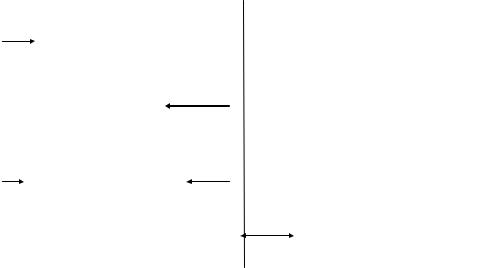
The operation part of the instruction is decoded so that the proper arithmetic or logical operation can be performed.
The address of the operand is sent from the instruction register to the address register.
At last the instruction counter register provides the address register with the address of the next
instruction to be executed.
2. The arithmetic logic unit (ALU), which performs mathematical calculations (addition, subtraction, multiplication, division and exponentiation, etc.) and logical operations (and, or, etc.). Data enter the ALU and return to main storage through the storage register. The accumulator serving as a register holds the results of processing operations. The results of arithmetic operations are returned to the accumulator for transfer to main storage through the storage register. The comparer performs logical comparisons of the contents of the storage register and the accumulator. At the core of the ALU is a very high-speed binary adder, which is used to carry out at least the four basic arithmetic functions.
3. The registers, which are high-speed units of memory used to store and control information. One of these registers is the program counter (PC) which keeps track of the next instruction to be performed in the main memory. Another is the instruction register (IR) which holds the instruction that is currently being executed.
|
Central Processing Unit (CPU) |
|
Organization of a simple |
|
|
|||||||||||||||||||||
|
|
|
|
|
|
|
|
|
|
|
|
|
|
|
|
|
||||||||||
|
|
|
CONTROL UNIT |
|
|
|
|
|
||||||||||||||||||
|
|
|
|
|
|
|
|
|
computer |
|
|
|
|
|
||||||||||||
|
|
|
|
|
|
|
|
|
|
|
|
|
|
|||||||||||||
|
|
|
|
|
|
|
|
|
|
|
|
|
|
|
|
The CPU is built into a |
|
|
||||||||
|
|
|
|
|
|
|
|
|
|
|
|
|
|
|
|
|
|
|||||||||
|
|
|
|
|
|
|
|
|
|
|
|
|
|
|
single microprocessor chip |
|
|
|||||||||
|
|
|
|
|
ARITHMETIC |
|
|
|
|
|
|
|||||||||||||||
|
|
|
|
|
|
|
|
|
|
|
|
|
|
|
|
|
|
|
|
|
||||||
|
|
|
|
|
LOGIC UNIT |
|
|
|
|
|
|
|
|
|
|
|
|
|
|
|
|
|||||
|
|
|
|
|
|
|
|
|
|
|
|
|
|
|
|
|
|
|
|
|
||||||
|
|
|
|
|
|
|
(ALU) |
|
|
|
|
|
|
|
|
|
|
|
|
|
|
|
|
|
||
|
|
|
|
|
|
|
|
|
|
|
|
|
|
MAIN MEMORY |
|
|
||||||||||
|
|
|
|
|
|
|
|
|
|
|
|
|
|
|
|
|
|
|
||||||||
|
|
|
|
|
|
|
|
|
|
|
|
|
|
|
|
|
|
|
|
|
|
|
|
|
|
|
|
|
|
|
|
|
REGISTERS |
|
|
|
|
|
|
|
|
|
|
|
|
|
|
|
|
||||
|
|
|
|
|
|
|
|
|
|
0 |
|
0 |
1 |
1 |
0 |
|
0 |
0 |
|
1 |
|
|||||
|
|
PC |
|
|
|
|
|
|
|
|
|
|
|
|
|
|
|
|
|
|
|
|
|
|
||
|
|
|
|
|
|
|
|
|
|
|
|
|
|
|
1 |
|
1 |
0 |
1 |
1 |
|
0 |
0 |
|
0 |
|
|
|
0 |
|
0 |
0 |
|
0 |
0 |
0 |
0 |
1 |
|
|
|
|
|
|
|||||||||
|
|
IR |
|
|
|
|
|
|
|
|
|
|
BUS |
|
|
|
|
|
|
|
|
|
|
|
|
|
|
|
0 |
|
0 |
0 |
|
1 |
1 |
0 |
0 |
0 |
|
0 |
|
1 |
0 |
1 |
1 |
|
0 |
1 |
|
0 |
|
||
|
|
|
|
|
|
|
|
|
|
|
|
|
|
|
|
|
|
|
|
|
|
|
|
|
|
|
|
|
0 |
|
1 |
0 |
|
1 |
1 |
0 |
1 |
0 |
|
|
0 |
|
0 |
0 |
0 |
0 |
|
0 |
1 |
|
1 |
|
|
|
|
|
|
|
|
|
|
|
|
|
|
|
|
|
|
|
|
|
|
|
|
|
|
|
|
|
|
|
|
|
|
|
|
|
|
|
|
|
|
|
|
|
|
|
|
|
|
|
|
|
|
|
|
The CPU coordinates all the activities of the various components of the computer. It determines which operations should be carried out and in what order. The CPU controls the operation of the entire system by issuing commands to other parts of the system and by acting on responses. When required it reads information from the memory, interprets instructions, performs operations on the data according to the instructions, writes the results back into the memory and moves information between memory levels or through the input-output ports.
The programs and data which pass through the central processor must be loaded into the main memory (also called the internal memory) in order to be processed. Thus, when the user runs an application, the microprocessor looks for it on secondary storage devices (disks) and transfers a
51
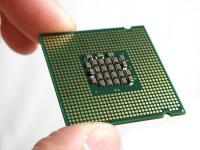
copy of the application into the RAM area. RAM (random access memory) is temporary, i.e. its
information is lost when the computer is turned off. However, the ROM section (read only memory) |
|
is permanent and contains instructions needed by the processor. The BIOS (basic input/output |
|
system) uses ROM to control communication with peripherals, e.g. disk drives. The amount of |
|
RAM determines |
the number of programs you can run simultaneously and how fast they operate. |
Most of today's |
computers have internal expansion slots that allow users to install adapters or |
expansion boards, which provide extra functions. |
Popular adapters include high-resolution |
graphics boards, memory expansion boards, and internal |
modems. |
The RAM capacity can sometimes be expanded by adding extra chips. These are usually contained in small circuit boards called single in-line memory modules (SIMMs). Modern Pentium processors also accept dual in-line memory modules (DIMMs) which allow for a wider data path.
One area where microprocessors differ is in the amount of data -
the number of bits - they can work with at a time. There are 16, 32 and 64-bit processors now and the computer's internal architecture is evolving very quickly.
The power and performance of a computer is partly determined by the speed of its microprocessor. The speed of a processor is measured in gigahertz (GHz). Thus, a CPU running at 4 GHz can make about four thousand million calculations a second. An internal clock sends out signals at fixed intervals to measure and synchronize the flow of data.
The main circuit board is known as the motherboard. This contains the CPU, the memory chips, expansion slots and controllers for peripherals, connected by internal buses, or paths, that carry electronic signals. For example, the front side bus carries all data that passes from the CPU to other devices.
VOCABULARY PRACTICE SECTION 2
1. Match the sentence beginnings (1-6) with the correct endings (a-f).
1.The CPU processes data and
2.The control unit is the part of the CPU that
3.The arithmetic and logic unit is able to make
4.The registers are high-speed storage
5.Data contained in RAM is lost when
6.ROM memory can only be read:
a.areas within the CPU.
b.you can't make changes to it.
с. calculations: add, subtract, multiply and divide.
d.the computer is turned off.
e.coordinates the other parts of the computer.
f.controls the way instructions are executed
52
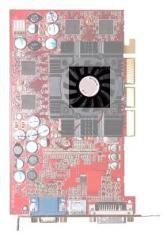
2. Match the terms with the definitions.
1. CPU |
a) performs the processing operations; |
2. CU |
b) carries out logical comparisons of storage; |
3. ALU |
с) executes basic arithmetic functions; |
4. accumulator |
d) coordinates the operation of the whole system; |
5. clock |
e) selects data from memory; |
6. counter |
f) produces electronic marks at regular intervals; |
7. register |
g) controls the flow between the primary storage and |
|
the arithmetic-logical unit; |
8. decoder |
h) keeps the instruction while it is being performed; |
9. comparer |
i) holds the results of processing operations; |
10. adder |
j) breaks the instructions into separate commands. |
3. Complete these definitions from an ICT dictionary by inserting terms from the box. Here is one extra word.
chip |
buses |
central processing unit |
clock |
speed |
control unit |
|
|
|
|
|
|
1. The ……. , or CPU, is like a ‘brain‘ which performs tasks for your computer.
2.The CPU is built into a single ……. that executes program instructions and coordinates activities within the system.
3.The ……. is the part of the processor which is responsible for loading and interpreting the
|
individual instructions that make up a computer program. |
4. |
……. is measured in gigahertz; for example, a processor running at 4Ghz would give you all |
|
the performance you need to run most applications. |
5. |
……. are electrical channels that allow devices inside the computer to communicate. |
4. Decide if the sentences are true (T) or false (F), and rewrite the false ones to make them true.
1. RAM stands for Random Access Memory.
2. If memory is volatile, it means that information is lost when the computer is turned off.
3.RAM is non-volatile. ROM is volatile.
4.DIMMs can be used to expand RAM capacity.
5. |
The CPU directs and coordinates the activities |
taking place within the computer system. |
6. |
The arithmetic logic unit performs calculations |
on the data. |
7. |
32-bit processors can handle more information |
than 64-bit processors. |
53
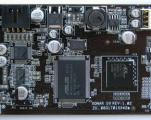
8. |
RAM, ROM and secondary storage are the components |
of the main memory |
9. |
A chip is an electronic device made of silicon elements containing a set of integrated circuits. |
|
10. Information cannot be processed by the microprocessor |
if it is not loaded into the main memory. |
|
11.Permanent storage of information is provided by RAM (random access memory).
12.The speed of the microprocessor is measured in gigahertz or megahertz.
13.One GHz is equivalent to one thousand MHz.
14. One MHz is equivalent to one million cycles per second.
5. |
Choose the correct word to fill the gaps. |
|
|
|
1. Computer data ………. system frees humans from routine error-prone tasks. |
|
|||
a) counting; b) computing; c) processing. |
|
|
|
|
2. |
Computers can store vast amount of information to organize |
it and ………. it. |
||
a) to travel; b) to retrieve; c) to respond. |
|
|
|
|
3. |
The entered data can be transmitted by ………. networks. |
|
|
|
a) communications; b) conversions; c) procession. |
|
|
||
4. |
The possibility of ………. is reduced if data were correctly put into the data processing system. |
|||
a) character; b) access; c) error. |
|
|
|
|
5. |
Computer data processing systems can ………. at a fraction |
of a second. |
|
|
a) receive; b) respond; c) retrieve. |
|
|
|
|
6. |
Computer systems are vulnerable to the entry of ……… data. |
|
||
a) invalid; b) invariable; c) invisible. |
|
|
|
|
7. Programs and data to be processed must be in the ……… memory. |
|
|||
a) internal; b) external; c) secondary. |
|
|
|
|
8. |
The results of arithmetic operations are returned to the ……. for transferring |
to main storage. |
||
a) decoder; b) counter; c) accumulator. |
|
|
|
|
9. |
The instruction to be ..... in control unit |
is read out from primary storage into |
the storage register. |
|
a) calculated; b) executed; c) read out. |
|
|
|
|
10. The ….. performs logical comparisons |
of the contents of the storage register |
and the .... . |
||
a) adder; b) accumulator; c) comparer. |
|
|
|
|
11. The read out command is passed from the ………. register |
to the ………. register. |
|||
a) instruction; b) address; c) storage. |
|
|
|
|
12. CPU is designed to ……. and to ………. basic instructions |
for the computer. |
|||
a) control; b) consist; c) carry out. |
|
|
|
|
13.CU and ALU consist of electronic circuits with millions of …… . a) sensors; b) servers; c) switches.
54
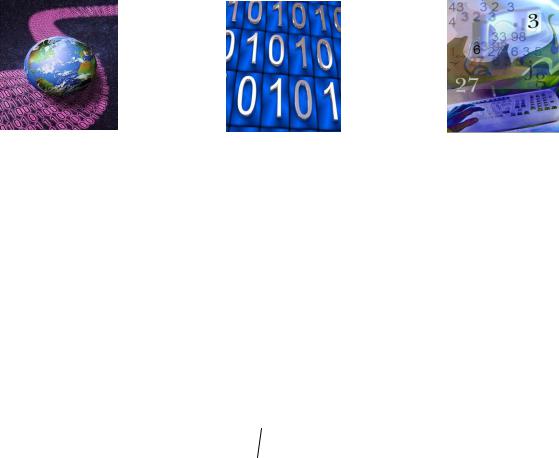
KEY INFORMATION SECTION 3
Bits - basic units of memory
Information is processed and stored in computers as electrical signals. A computer contains thousands of electronic circuits connected by switches that can only be in one of two possible states: ON (the current is flowing through the wire) or OFF (the current is not flowing through the wire). To represent these two conditions we use binary notation in which 1 means ON and 0 means OFF. This is the only way a computer can 'understand' anything. Everything about computers is based upon this binary process. Each 1 or 0 is called a binary digit or bit.
1s and 0s are grouped into eight-digit codes that typically represent characters (letters, numbers and symbols). Eight bits together are called a byte. Thus, each character in a keyboard has its own arrangement of eight bits. For example, 01000001 for the letter A, 01000010 for В.
|
|
one bit |
|
||
|
|
|
|
|
|
|
|
|
|
|
|
|
|
|
|
|
|
|
|
010001 |
|
|
|
|
|
|
|
|
|
|
|
|
|
|
|
|
example |
of a byte |
|
||
The majority of computers use a standard |
|
|
|
|
binary representation of characters. |
system |
for the |
||||
This is the American Standard Code for Information Interchange, known popularly as ASCII (pronounced 'ask-key'). There are 256 different ways of combining 0 and 1 bits in a byte. So they can give us 256 different signals. However, the ASCII code only uses 128 bytes to represent characters. The rest of the bytes are used for other purposes.
The first 32 codes are reserved for characters such as the Return key, Tab, Escape, etc. Each letter of the alphabet, and many symbols (such as punctuation marks), as well as the ten numbers, have ASCII representations. What makes this system powerful is that these codes are standard.
In order to avoid astronomical figures and sums in the calculation of bytes, we use units such as kilobytes, megabytes and gigabytes. One kilobyte is 1,024 bytes (2¹º) and it is represented as KB, or more informally as K. One megabyte is equivalent to 1,024 KB, and one gigabyte is 1,024 MB. We use these units (KB, MB, GB) to describe the RAM memory, the storage capacity of disks and the size of any application or document.
55

VOCABULARY PRACTICE SECTION 3
1.Fill in the blanks with the correct units of memory.
1.One ……. represents one character.
2.One ……. represents 1024 characters (about a small page of text).
3.One ……. represents about one million characters (about the text of a small book).
4.One ……. represents about 1 000 000 000 characters (about 1000 books).
5.One ……. represents about 1 000 000 000 000 characters (about one million books in a big library).
2.The table gives some prefixes commonly used in computer science. Knowing the meaning of these prefixes will help you understand new words.
Prefix |
Meaning |
|
|
Examples |
|
|
|
|
|
|
|
|
|
deci- |
ten |
|
|
decimal, |
decimalize, |
decibel |
hexadeci- |
sixteen |
|
|
hexadecimal |
|
|
kilo- |
one thousand (1,000) (1,024 in binary: 2¹º) 210) |
kilocycle, |
kilogram(me), kilowatt |
|||
mega- |
large; one million |
|
megahertz, megalith, |
megaton |
||
giga- |
very large; |
one thousand million |
gigabyte, |
gigahertz |
|
|
mini- |
small |
|
|
minibus, |
minimum, |
minimize |
micro- |
very small |
|
|
microfilm, microphone, microwave |
||
bi- |
two |
|
|
bidirectional, bidimensional, binary |
||
tri- |
three |
|
|
tripartite, |
tricycle, trilingual |
|
multi- |
many |
|
|
multi-racial, multi-user; multitasking |
||
mono- |
one |
|
|
monologue, monolingual |
||
|
|
|
|
|||
Explain these expressions, taking into account the prefixes and root word. |
|
|||||
Example: the binary system |
- The binary system is a notation which uses two digits, 0 and 1. |
|||||
a minicomputer |
the hexadecimal system |
a monochrome computer display |
||||
a microcomputer |
a multi-user |
configuration |
a CPU with 256 MB of RAM |
|||
the decimal system |
a bidimensional chessboard |
a document of 3 kilobytes |
||||
|
|
a tricycle |
|
|
|
|
56

3.Complete these sentences by inserting a unit of memory.
1.A ……. is the smallest unit of information in a computer that must be either 0 or 1. Eight of these make a …….
2.A ……. is approximately one million bytes.
3. One of the largest units of memory is a ……. – equivalent to all the books in a large library.
4.A DVD-RW can usually store 4.7 ……. of data.
5.A ……. is around 1000 bytes.
GRAMMAR PRACTICE SECTION
Verb + -ing or infinitive.
1. Match the sentences with the explanations.
1.Verb+-ing
2.Verb+being+verb in the 3rd form
3.Verb+-ing/infinitive=little change in meaning
4.Verb+to be+verb in the 3rd form
5.Verb+object+to+infinitive
6.Verb+bare infinitive (without to)
7.Verb+-ing/infinitive=change in meaning
8.Verb+to+infinitive of purpose
9.Verb+to+infinitive
a.They stopped looking/to look at the flowchart.
b.To prevent anyone changing the data he disabled the keyboard.
c.The programmer didn‘t let me install this new operation system.
d.Some viruses cause computers to crash.
e.Some people can‘t afford to buy a modern PC.
f.The company intends to use/using computers in the production process.
g.Invalid data risks being processed incorrectly.
h.Any new software requires to be tested before use.
i.Analytical engine was invented to store data.
2. Put the verbs in brackets into the correct form (–ing or infinitive). Sometimes both are possible.
1. |
Backing up involves (copy) current working files |
onto a separate storage disk. |
|
2. |
Don't forget |
(save) the file before switching off. |
|
3. |
The engineer |
managed (recover) all the lost data, though it took a long time. |
|
4. |
I remember (shut) down the computer before I left |
the room. |
|
5. |
Scientists considered silicon (be) one of the best materials for the creation of an IС. |
||
57
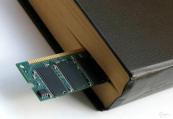
6.Experts expect computers (become) the most commonly used devices.
7.If you don‘t save your document every few minutes you risk (lose) all the work you‘ve done.
8.Keyboard enables (input) numerical and text data.
9.They want this software (simulate) the action of an aircraft.
10.This program seems (work) correctly the first time it is tested.
11.Computers were designed (perform) thousands of computations per second.
12.Engineers expect these new devices (test) very soon.
13.The hacker denied (break) into our computer system.
14.Banks spend millions of dollars (try) to stop new kinds of computer crime.
15.Blue-ray discs let you (store) far more data than DVD discs.
16. Using computers (create) graphics and sounds, virtual reality makes the viewer (believe) he or she is in another world.
READING PRACTICE SECTION
Looks good on paper
A new use for a common material
Once in a while, someone takes a familiar material like glass and finds a new use for it. Glass had been around for ages but, in the 1950s, Basil Hirschowitz of the University of Michigan thought of using a fibre made of the stuff to transmit light. Fibre optics have since revolutionised both surgery
(Dr Hirschowitz‘s |
original |
intention) |
and telecommunications (an unexpected bonus). Elvira |
Fortunato, Rodrigo |
Martins |
and their |
colleagues at the New University of Lisbon in Portugal |
believe they have found similarly a novel use for paper. Writing in IEEE Electron Device Letters, they describe how to use it to make a transistor.
Transistors are the workhorses of electronics. They are switches that employ one electric current to control the passage of another. Linked together on the surfaces of silicon chips, they form the ―logic gates‖ that do the calculations in computers, mobile phones, television sets and the other electronic gadgets which dominate the modern world. The bold proposal that Dr. Fortunato and Dr. Martins are making is to replace the silicon with cellulose, the main ingredient of paper.

 The silicon in a transistor has two separate roles. One, when it is doped with small amounts of other elements, is as a semiconductor. This is a material that permits the limited movement either of electrons (which are negatively charged) or of positively charged ―holes‖ in the crystal lattice where an electron ought to be. Silicon‘s other role, when it is pure, is as a dielectric—
The silicon in a transistor has two separate roles. One, when it is doped with small amounts of other elements, is as a semiconductor. This is a material that permits the limited movement either of electrons (which are negatively charged) or of positively charged ―holes‖ in the crystal lattice where an electron ought to be. Silicon‘s other role, when it is pure, is as a dielectric—
58

a material that can be penetrated |
by an electric field, but not an electric current. It is silicon‘s role as |
||
a dielectric |
that Dr Fortunato and Dr Martins |
propose to replace. |
|
The two |
researchers built their |
transistors |
by coating both sides of a sheet of paper with |
semiconductors made of oxides of zinc, gallium and indium, rather than silicon. They then deposited aluminium onto the coated paper to connect the resulting components together. One side of the paper carried the control currents while the other carried the output currents. The paper thus acted as the dielectric between the components of each transistor, as well as being the substrate for the circuit, in the same way that the base of a silicon chip acts both as substrate and as dielectric.
This approach lets the transistors be both flexible and cheap to produce. They can be made at room temperature, unlike a silicon chip, and paper is a lot less pricey than electronics-grade silicon. They also seem reliable. Dr. Fortunato and Dr. Martins tested their prototypes for two months without detecting any fall in performance.
Paper transistors, and circuits based on them, are not, it must be said, going to replace silicon chips as the microprocessors in computers any time soon—if only because they are nowhere near as miniaturised. But the two researchers have already used them to make a simple, disposable memory circuit, which they will describe in a forthcoming issue of Applied Physics Letters. Such paperbased ―chips‖ would be much cheaper than the cheapest chips available today, and could be used in radiofrequency identification (RFID) tags on such things as packets of food on supermarket shelves—the cost of RFID chips is one of the factors preventing their widespread adoption. Baggage tags, banknotes with electronics embedded for security and even postage stamps that can be read by smart franking machines are other possible uses. Electronics may even come to rely on paper, rather than eliminating it.
Read the comments to the article. Which comments do you agree with? Why? What is your opinion on the article and on the technology it talks about? Do you think there is a future for it? What would you write to comment it?
Readers’ comments. |
|
1. Interesting. But, I shudder to think of the future. We will have |
these tags |
on all forms of paper; we would have a major problem in recycling |
paper. |
2. Hm. Lots of interesting uses. E.g.: Spy Paper. Paper with microphone circuitry and transmission circuitry to "bug" anything from memos to newspapers to magazines to ... unobtrusively. What fun!
3. At least we know already that this simple technology not only looks good on paper. But can be of use in ways so helpful to the modern issues of global warming and CO2 in the air.
4. Balance is what nature even does well if we were left out of the picture. This new use could be a new balance.
59
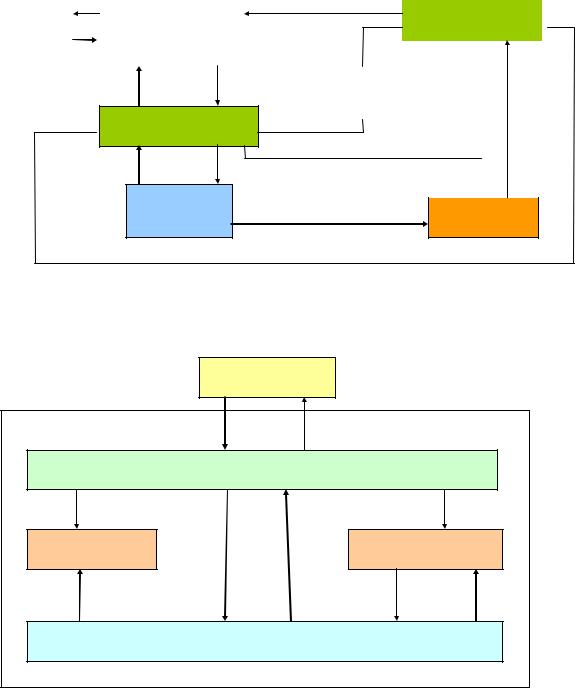
SPEAKING/WRITING PRACTICE SECTION
1. Describe the schemes:
1. Communication between the primary storage unit and the arithmetic-logical and control units
Input and |
Primary |
storage |
|
Address register |
output |
(bits, |
bytes, |
|
|
processors |
fields, |
words) |
|
|
|
|
|
|
|
Data and instructions
Storage register
Arithmetic-  logical unit
logical unit  Control unit
Control unit
2. Arithmetic-logical unit functional diagram
|
Primary storage |
|
Storage register |
Comparer |
Adder |
|
Accumulator |
60
